Last Updated on July 11, 2024 by lindseymahoney
I have tackled many home renovation projects in my day, but painting the basement ceiling black was the most physically taxing DIY yet. Don’t get me wrong, it was totally worth it for the look and the money saved, but it was exhausting!
In total, it took me 10-12 hours to paint about 1,500 square feet of our basement ceiling. Let’s go through exactly how to paint a basement ceiling with a budget-friendly tutorial that will completely change the overall feel and look of the space!
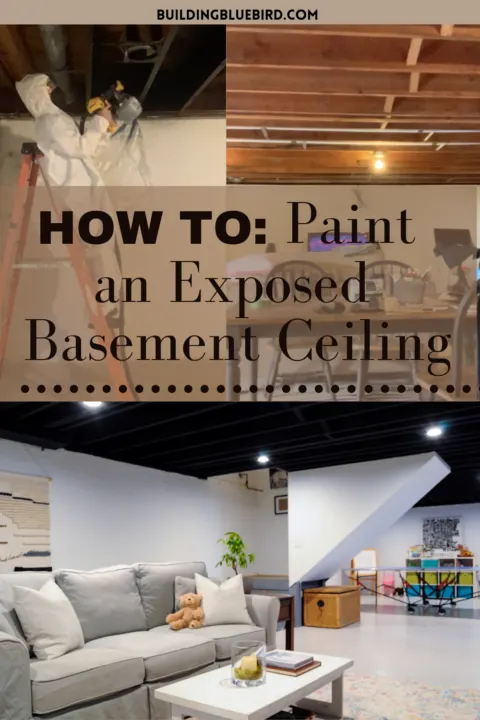
Our basement ceiling went from looking like this:
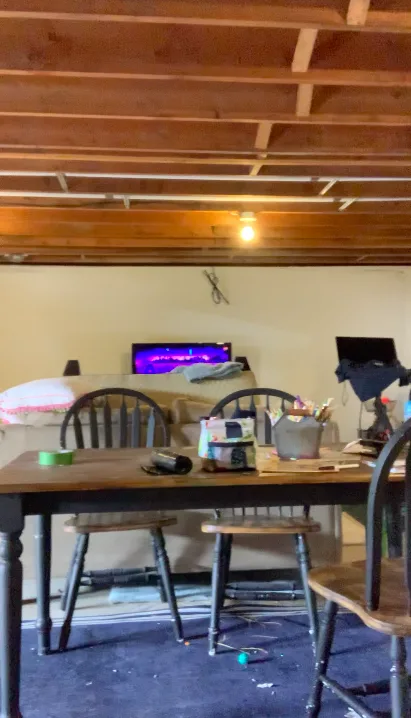
To this:
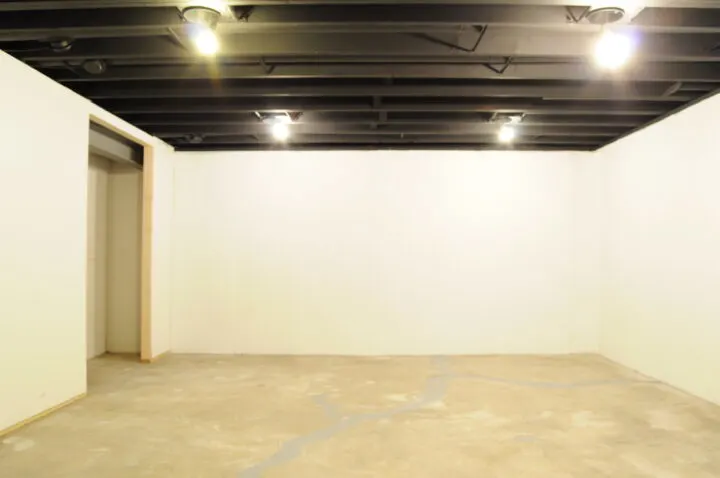
So much better, right?!
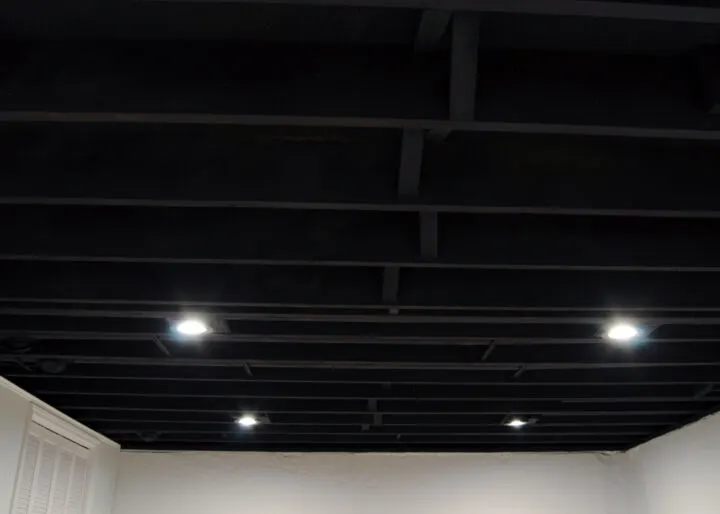
Table of Contents
- How to Paint an Exposed Basement Ceiling Black
- 1 | Organize Electrical Wires in the Ceiling
- 2 | Add Electrical and Overhead Light Fixtures (if needed)
- 3 | Clean the Basement Ceiling Joists
- 4 | Protect the Basement Walls and Floor From Paint
- 5 | Paint the Exposed Basement Ceiling
- 6 | Install Can Lights
- Pros and Cons of Painting an Exposed Basement Ceiling
- Painted Black Basement Ceiling Reveal
- More Content You Will Love
- Frequently Asked Questions
*Check out the complete unfinished basement makeover reveal!
How to Paint an Exposed Basement Ceiling Black
[affiliate links included in this post, thank you for supporting Building Bluebird!]
Project Source List:
- Valspar 2000 Flat Black Interior
- Coveralls with a hood
- Protective eyewear
- N95 mask or Respirator
- Wagner Spraytech Flexio 5000
- Dropcloth and Plastic Sheeting
- Work platform and/or ladder
- Wire Cutter
- Cord Staples
- Broom or Leaf Blower
- Shop Vac
- Black can lights
- Dimmer Switches
1 | Organize Electrical Wires in the Ceiling
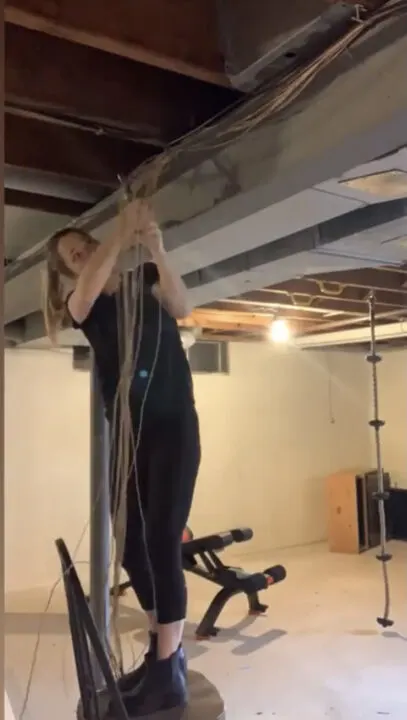
Before painting the ceiling, it is important to organize and remove any old wiring and pin any active electrical wire to the joists using cord staples. This will help conceal the wires once the ceiling is painted.
Our basement ceiling had old TV cable and alarm system wires that I easily removed. I used a wire cutter to remove the old wires.
For any loose wires that needed to stay, I pinned them to the side of a joist for a clean look.
2 | Add Electrical and Overhead Light Fixtures (if needed)
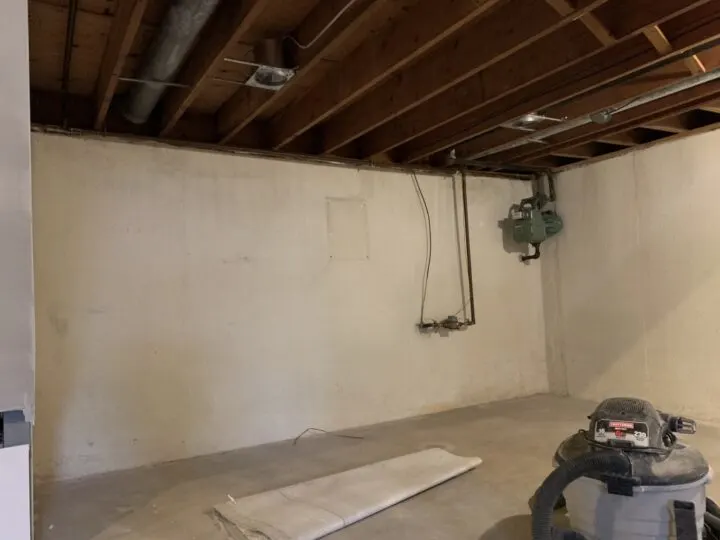
Our basement lighting consisted of only pull-string lights. I hired an electrician to install overhead lighting that we could turn on and off with a few switches.
Because I wanted everything on the ceiling black, I had the boxes installed before I began painting the ceiling.
Before the electricians got started, I asked that they attach the wires to the joists. If they needed to cross any joists I asked them to try and do it at the edges of the room so it wasn’t noticeable.
Never assume that contractors know how you want something to look. You know the saying, “assuming makes an ass out of you and me!”
3 | Clean the Basement Ceiling Joists

Removing dirt and dust from ceiling joists can be accomplished in a few different ways. I found that using a broom to brush away any dust and cobwebs was the most effective for me.
I also tried a leaf blower which would have been great if I was properly dressed and our basement wasn’t filled with our furniture. If your basement is empty, throw on some goggles and go to town with the blower.
Finally, I utilized our shop vac to remove larger debris found on the support beams or ledges of the wall.
4 | Protect the Basement Walls and Floor From Paint
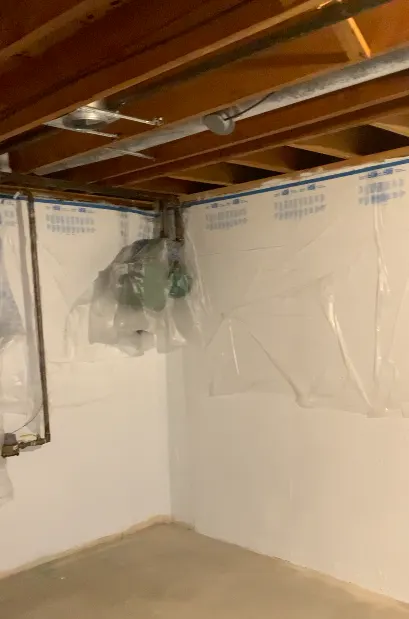
If you have plans to paint the basement floor and walls, start with the ceiling first!
I know this rule, but still got antsy and decided to apply the first coat of paint onto the walls before spraying the ceiling.
Because I followed the steps out of order, I spent a whole day taping plastic sheets on the walls only to have all of it blow away as soon as I turned on the paint sprayer!
Next time I will follow my own advice and skip painting the walls until the ceiling is completely finished.
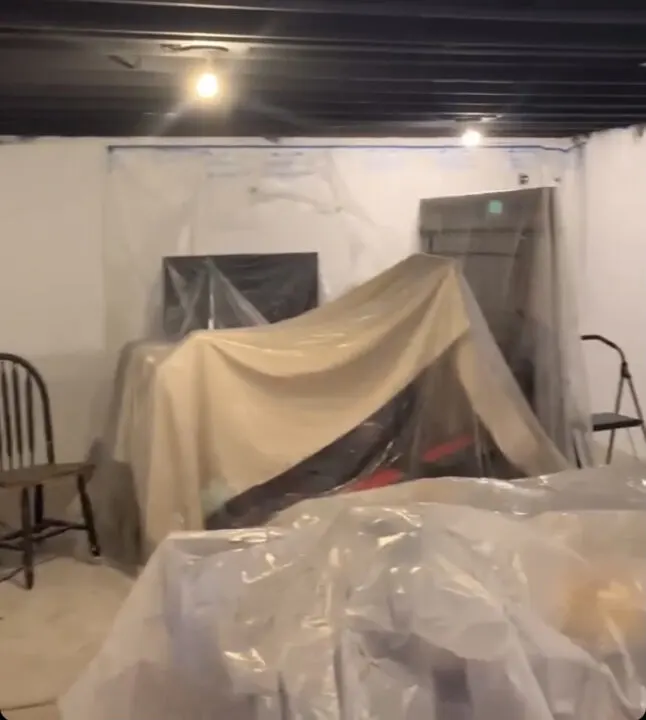
To protect large items that are staying in the basement, move them into the center of the room and cover them with drop cloths and plastic sheeting.
If you are not updating your basement floors, I recommend covering those as well. Our concrete floor had black speckled paint all over once the ceiling was finished, but I didn’t mind since the floors would be painted next.
Paint Protection Gear
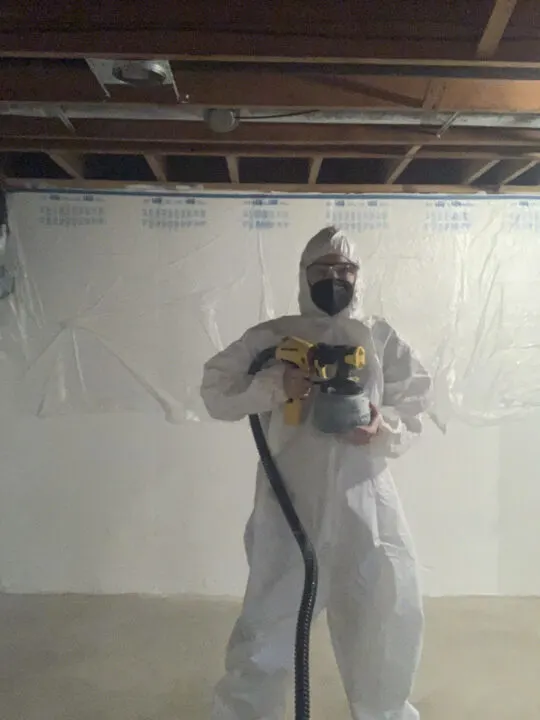
You also want to get protective gear for yourself. I wore a full body suit, protective eyewear, and an N95 mask. Gloves are a good idea too, but I decided not to use them.
I used a nail brush in the shower on my hands to remove any paint and it worked well but it does make them quite dry.
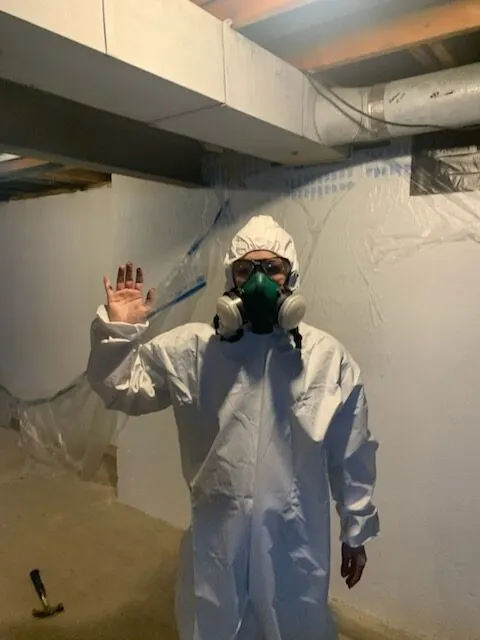
My father-in-law saw my standard mask in the photo above and immediately drove to my house to give me a respirator to use.
I used the respirator about half of the time but it would slip off of my head after a while.
My preferred mask for this task was the disposable N95 mask with the mini respirator. Side note: We could not stop laughing at these pictures with me all geared up!
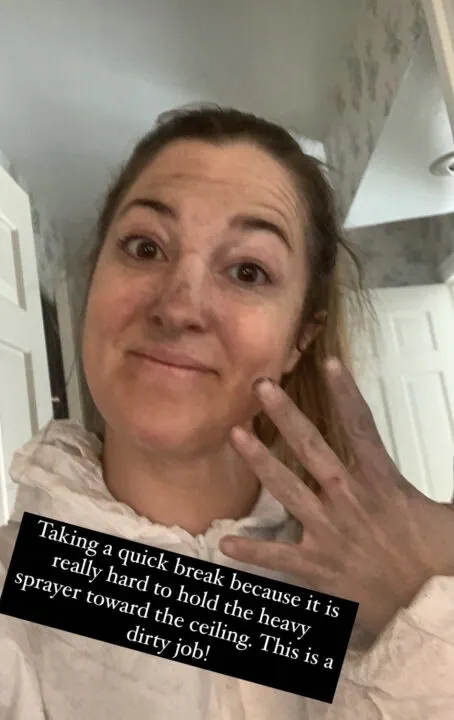
Even with my protective gear, I still had paint all over my face and hands at the end of the day.
5 | Paint the Exposed Basement Ceiling
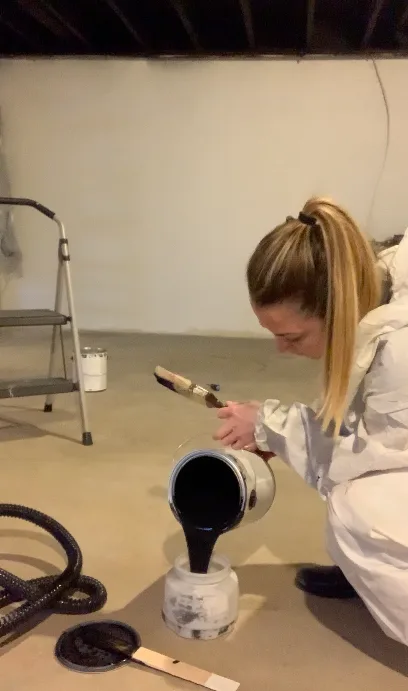
For this project, I used my Wagner Flexio 5000 to spray paint the basement ceiling black. It is really easy to use, but it took a long time. A paint sprayer is a MUST to effectively paint all of the nooks and crannies on the ceiling.
I heard from multiple people after I finished this project that renting an industrial sprayer from Home Depot would have cut my time in half.
I am guessing this is the paint spray gun that professional painters use and is a great option to speed up the painting process.
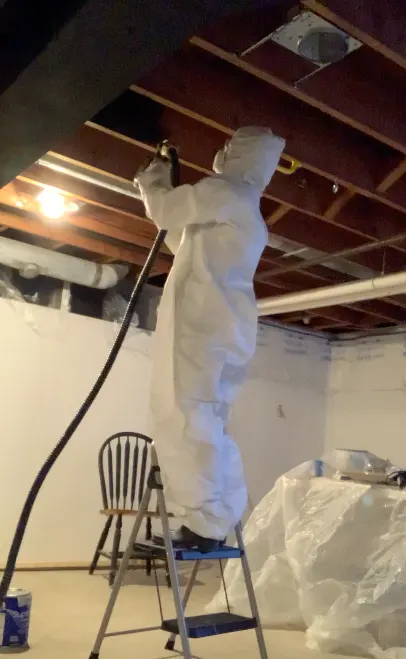
As I mentioned above, this project took about 10-12 hours! I packed it into 2 days and had to see a chiropractor afterward.
Looking up at the ceiling, holding a paint sprayer, and consistently pulling the trigger starts to hurt after a while! I would recommend taking more time if you can.
I followed the paint sprayer manual recommendations when setting up the machine to paint the ceiling. You can change the size of the spray coverage and the air pressure depending on your project.

I used the latex paint settings and kept the material flow between 9-11 and the airpower on med-hi.
We chose Valspar 2000 flat black ceiling paint and used 6 gallons of paint. I decided to go with black paint for the basement ceiling because I wanted to camouflage the wires and pipes as much as possible.
White looks really nice as well but was not the look I was going for. With the can light placement, there is no light shining on the ceiling joists and it just disappears.
Paint Sprayer Tips
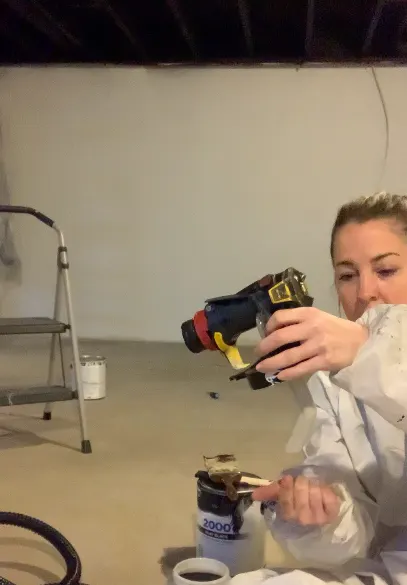
Because I had the sprayer tilted back as I sprayed the ceiling, I angled the intake tube towards the back so it would suck up all of the paint.
If I were pointing the sprayer downward to spray a kitchen cabinet, for example, the intake tube would be angled toward the front of the sprayer.
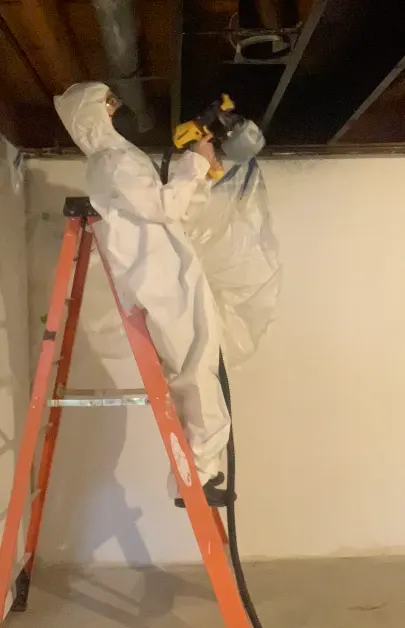
It took me a little bit to figure out the best way to use the paint sprayer, but once I got my system down, it was easier to get all of the hard-to-reach areas on the ceiling.
I primarily used the horizontal spray position to cover in between the joists.
Then I switched to the vertical spray option where I moved the sprayer up and down when there was a narrow area to cover.
Paint Touch-Ups
After spraying the unfinished basement ceiling for two days, I decided that one coat of paint was enough!
I touched up any areas that needed some more coverage with a paintbrush and a small roller.
Applying a second coat of paint is always better than one, but I was not interested in tackling that project.
The single coat of paint looks great and unless you are looking to find spots that may need more paint, you do not notice it at all.
*Check out my recommended supplies for painting interior spaces.
6 | Install Can Lights
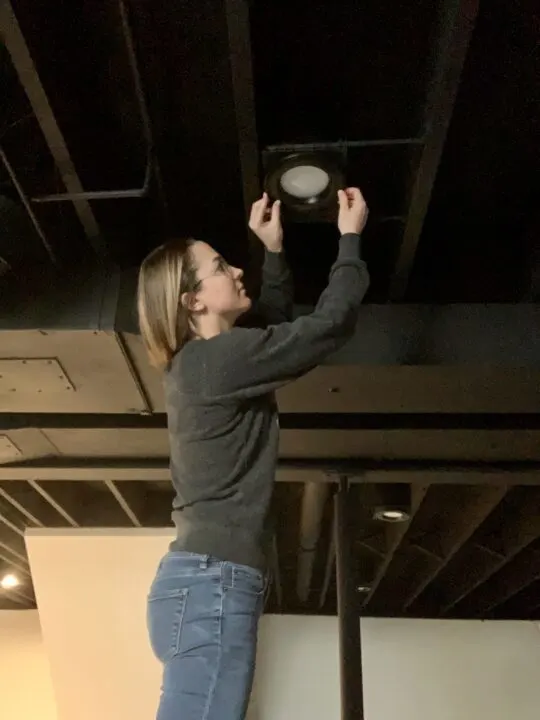
I chose black can lights to match the black paint and it looks so good! We added dimmers to the switches too.
I like having the option to dim the lights for a movie or while we are working out.
Removing the pull lights with hanging bulbs and adding can lights completely elevated the look of our basement.
Pros and Cons of Painting an Exposed Basement Ceiling
Pros:
- More affordable than a new drop ceiling or drywall
- It gives the basement a cool, industrial look
- Gives the appearance of a high ceiling with a dramatic effect when paired with a neutral color on the walls
- Easy access to the mechanicals of the house when necessary
Cons:
- If you DIY this project, it can be time-consuming and exhausting
- There is no sound buffer that a drop ceiling and drywall can add
Painted Black Basement Ceiling Reveal
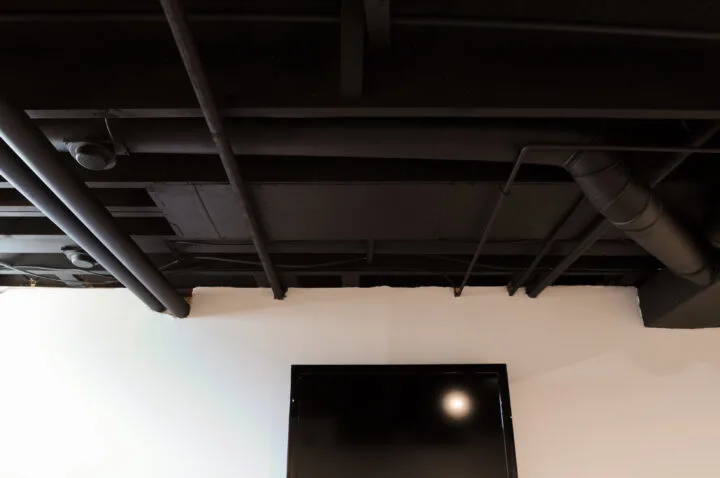
I am so happy with how the black exposed basement ceiling turned out!
It looks completely different from when we first started this project. The flat black ceiling paint gives each area a clean and cohesive feel.
Below is the workout area before we painted the floors.
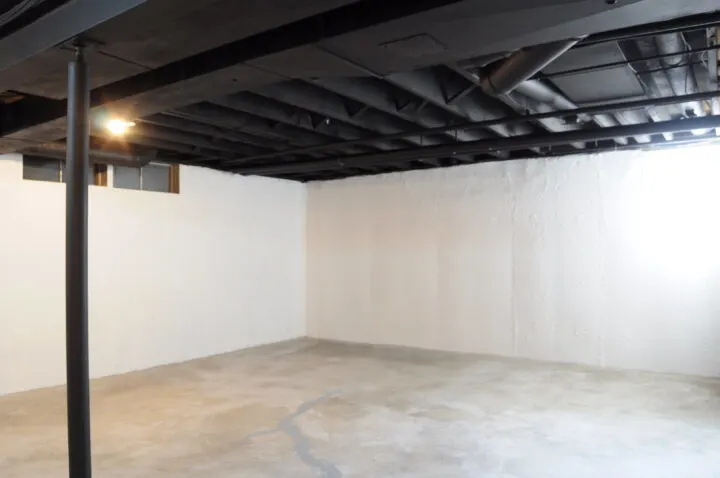
Here is the basement once the concrete floors and walls had been painted. It has such a cozy feel in the kids’ new hangout space!
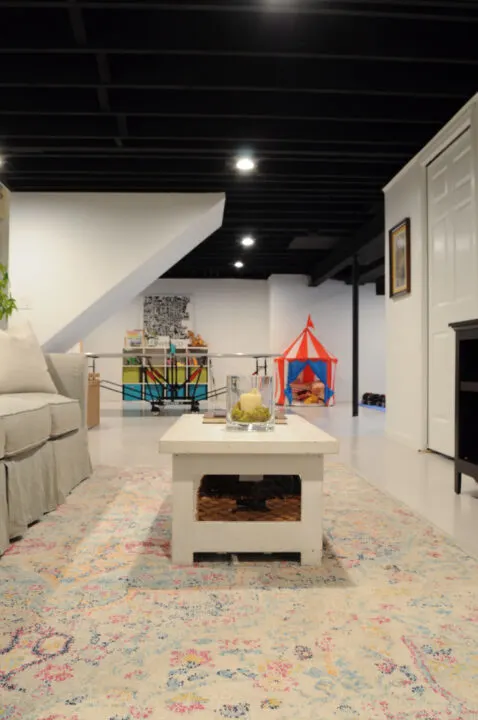
Here is another great before shot of the basement:
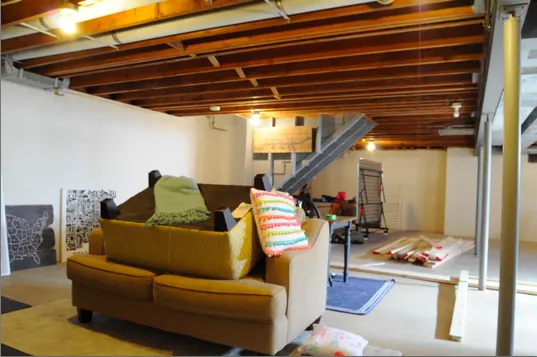
And that same view after!
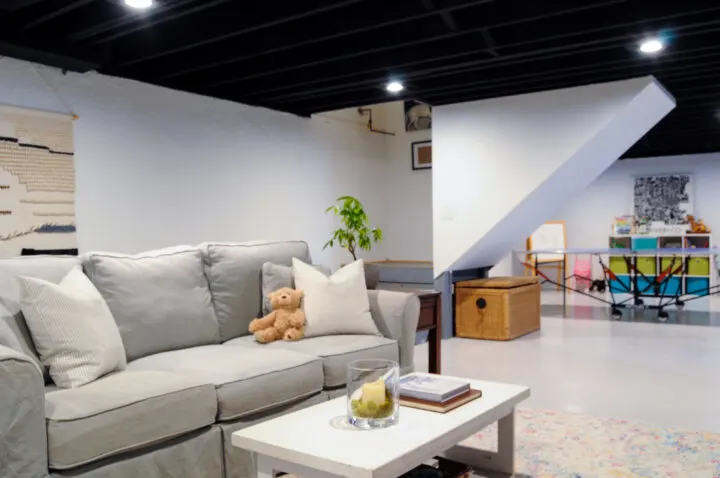
I am thrilled with how our unfinished basement looks and our family uses the entire space daily.
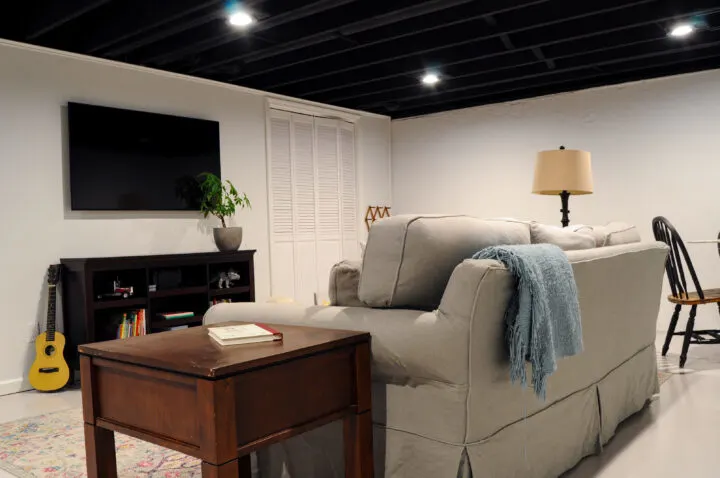
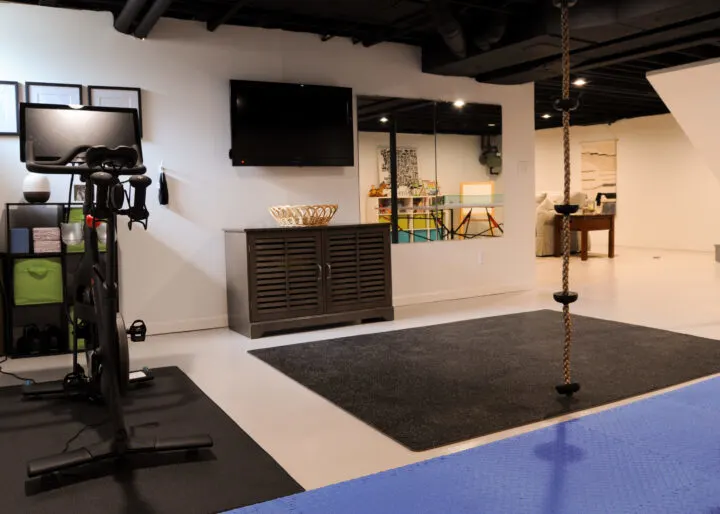
Painting the unfinished ceiling is a great way to update your basement on a small budget. Using a paint sprayer will give you the best results and speed up the project.
I hope these tips inspire you to add livable square footage to your basement by painting the ceiling yourself! Good luck!
More Content You Will Love
- 10 Most Popular Farrow and Ball Paint Colors
- 25+ Easy Outdoor DIY Projects to Try This Year
- How to Paint a Dated Rock Fireplace | DIY
- Laundry Room Makeover on a Budget
- I Applied Latex Over Oil Based Paint | How To Fix
- How to Paint Your Old Floors Using Rust-Oleum HOME
- How to Lay Brick Border Garden Edging | Easy DIY
- Paint Your Basement Stairs Black for a Modern Look
Frequently Asked Questions
What is the best kind of paint to use on the exposed basement ceiling?
I used standard latex ceiling paint that can be used in handheld paint sprayers. A flat sheen is the best option when painting ceilings to hide imperfections and purchased Valspar 2000 flat black ceiling paint for this specific DIY project.
What is the best paint color for exposed basement ceilings?
Painting the exposed ceiling one color will give it a nice, cohesive look. Your paint color choice is really a personal preference. A white paint color on the ceiling will brighten the room and give it a larger appearance. This is an excellent choice for a basement with a low ceiling. A white ceiling will need a few coats of primer before applying the finish paint because bare wood ceiling joists will suck up the paint quickly.
Dark colors on the ceiling, like black, make a room feel more grounded and hides imperfections. The best ceiling color varies depending on the characteristics of the room and the goals of the homeowner.
How much does it cost to paint a basement ceiling?
The cost of this DIY project will vary based on the size of the basement. You will need to purchase paint and supplies and either rent or buy a paint sprayer.
The surface of our basement ceiling is about 1500 sq ft and the main cost for this DIY project was purchasing the paint cans. Painting our basement ceiling cost about $200.
What do you do about parts of the ceiling that the paint sprayer can’t reach?
After I sprayed the ceiling, I went back and used a handheld paintbrush to cover any missed areas. A paint roller will be helpful with covering any uneven areas if you don’t want to do additional coats of paint. There are definitely imperfections with the paint coverage, but they are not noticeable once the can lights are on.


Ray
Friday 12th of July 2024
Before painting,what should be done with exposed insulation between the joists at the top of the wall?
lindseymahoney
Monday 15th of July 2024
Hi Ray, my basement does not have any visible insulation between the joists so I did not have to do anything prior to painting.
Ray
Friday 12th of July 2024
Before painting,what should be done with exposed insulation between the joists?
Jessi
Saturday 6th of July 2024
Amazing post. Thank you!
I am almost done prepping the basement for painting the ceiling. That in itself is a lot of work! Couple of questions for you:
1. I too painted a few walls first and just finished taping all walls so I have a nince line before I hit the spray foam insulation around the perimeter of the upper part of the wall. Why did your plastic blow away? Exhaust from the paint sprayer? If I go nuts with the tape do you think I can avoid this?
2. I love your can lights! Love it. I looked at the link and don't see the housing that spans between the rafters. What is that called and where and which one did you buy. BTW, I am going white with the ceiling. My ceilings are lower so think it might help it feel more spacious.
3. I kind of want to paint the ceiling first, then do the electrical. What was your thinking around electrical first, then ceiling? I guess they will be cutting some new holes etc., but ugh, now that I taped everything they may have to untape. Well, I guess I'll learn my lessons along the way.
Thank you for any advice or thoughts you have.
lindseymahoney
Sunday 7th of July 2024
1. Yours may be fine, my concrete walls didn't hold the tape wells o the air from the sprayer immediately blew it off. 2. The electricians put in the housing for the can lights so I don't have a link. It will have to be the proper size for the can light you decide to purchase. 3. I think it looks best to do electrical first so you can paint the can light housing and the electrical wires the same color as the ceiling. Especially with white - the wiring may stick out like a sore thumb.
Nihar
Friday 15th of March 2024
We have nails sticking out from the floor above it. Did you have those? I heard on another video that they added insulation boards between joists before painting. That can potentially hide the nIls.
lindseymahoney
Monday 18th of March 2024
Yes, we sprayed right over the nails. Adding insulation will help with the sound barrier for sure. We may do something like that in the future because you can hear whats going on in the basement when you are directly above it.
Jill
Thursday 4th of January 2024
Amazing! We're looking at doing this too but my husband is concerned about deciphering which pipe is what after painted. Did you have a system or anyway to organize and tell what goes to what easily in case any wires or pipes need fixing
lindseymahoney
Friday 5th of January 2024
It is pretty easy to decipher which is which, especially if we follow it across the ceiling, we can usually figure out what it is for. Maybe make a little map to reference before painting it so you know what each one goes to.